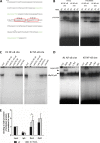NF-κB/RelA controlled A20 limits TRAIL-induced apoptosis in pancreatic cancer
- PMID: 36596765
- PMCID: PMC9810737
- DOI: 10.1038/s41419-022-05535-9
NF-κB/RelA controlled A20 limits TRAIL-induced apoptosis in pancreatic cancer
Abstract
The emergence of resistance to systemic therapies in pancreatic ductal adenocarcinoma (PDAC) is still a major obstacle in clinical practice. Both, constitutive and inducible NF-κB activity are known as key players in this context. To identify differentially expressed and TRAIL resistance mediating NF-κB target genes, TRAIL sensitive and resistant PDAC cell lines were analyzed by transcriptome assays. In this context, A20 was identified as an NF-κB/RelA inducible target gene. Translational PDAC tissue analysis confirmed the correlation of elevated A20 protein expression with activated RelA expression in PDAC patients. In in vitro experiments, an elevated A20 expression is accompanied by a specific resistance toward TRAIL-mediated apoptosis but not to chemotherapeutic-induced cell death. This TRAIL resistance was attributed to A20´s E3-ligase activity-mediating Zink finger domain. Furthermore, the ubiquitin-binding scaffold protein p62 was identified as indispensable for the TRAIL-mediated apoptosis-inducing pathway affected by A20. The results of this study identify A20 as a possible therapeutic target to affect resistance to TRAIL-induced apoptosis in PDAC cells.
© 2023. The Author(s).
Conflict of interest statement
The authors declare no competing interests.
Figures







References
-
- Dagenais GR, Leong DP, Rangarajan S, Lanas F, Lopez-Jaramillo P, Gupta R, et al. Variations in common diseases, hospital admissions, and deaths in middle-aged adults in 21 countries from five continents (PURE): a prospective cohort study. Lancet. 2020;395:785–94. doi: 10.1016/S0140-6736(19)32007-0. - DOI - PubMed
Publication types
MeSH terms
Substances
LinkOut - more resources
Full Text Sources
Medical

